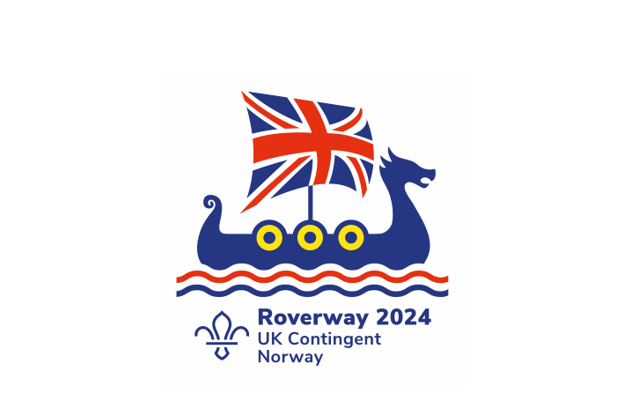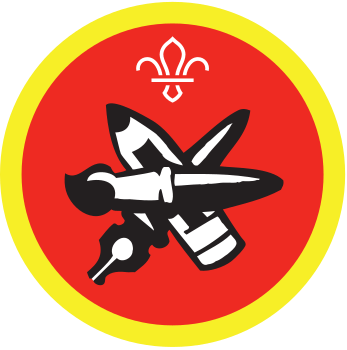
Make Northern Lights chalk art
You’ll need
- Black or navy card
- A mix of chalk colours
- Cotton balls (optional)
- Craft sponges (optional)
- Photos of the Northern Lights (optional)
Før du begynner (Before you begin)
- Use the safety checklist to help you plan and risk assess your activity. Additional help to carry out your risk assessment, including examples can be found here. Don’t forget to make sure all young people and adults involved in the activity know how to take part safely.
- Make sure you’ll have enough adult helpers. You may need some parents and carers to help if you’re short on helpers.
Gjør klar denne aktiviteten (Setting up this activity)
-
You may want to find or print pictures of the Northern Lights to show everyone what they look like.
Roverway is a European event for Scouts and Guides aged 16 to 22, which takes place every three to six years. It is a unique event due to its age range and emphasis on youth-led adventure.
The next Roverway will take place in Norway in summer 2024. The event is divided into three parts: a semi-independent expedition, a jamboree-style camp and a post-event experience. Find out more on our Roverway 2024 page.
Norway is a Scandinavian country in Northern Europe that has mountains, glaciers and big bodies of water, which are called fjords. Many Norwegians embrace the nature through outdoor activities such as kayaking, hiking and skiing. Oslo is the capital of Norway.
The Aurora Borealis, or Northern Lights, is a spectacular natural light display. The phenomenon appears as shimmering waves of light in the sky. They’re often green, red, pink, purple and blue. The Northern Lights are caused by charged particles from the sun hitting gases in the Earth’s atmosphere, in a similar way to how fluorescent light tubes and neon signs work.
They occur around the North Pole when the solar wind carrying the particles interacts with the Earth’s magnetic field. Green is the most common colour, which occurs when the particles hit oxygen in the lower atmosphere. Red appears when the particles hit oxygen in the upper atmosphere, while blue or purple occur when nitrogen is involved.
The Northern Lights are most active in March and September, according to the Met Office, during the Equinox. This is when the Earth is not tilted towards or away from the Sun. The Northern Lights don’t happen every night, only when a radiation storm or geomagnetic storm occurs in the Earth’s atmosphere.
The Northern Lights form in an oval around the Earth’s North Pole in an area called the auroral zone. Areas in the auroral zone include north Norway, Sweden, Finland, Iceland, Greenland, and Canada, the north of American state Alaska, and northern Siberia, in Russia.
This zone will bulge and move depending on the geomagnetic activity, but the most reliable locations are places like Scandinavia, Iceland and Canada. In the UK, the greatest probability of seeing the Northern Lights is in Scotland, Northern Ireland and northern England, according to Met Office.
The Aurora Borealis is the scientific name for the Northern Lights, named after the Roman goddess of dawn, Aurora, and the Greek god of the north wind, Boreas. Similar lights can be seen near the South Pole, which are called the Aurora Australis after the Greek god of the south wind, Auster.
Lag Bildet (Make the Picture)
- Gather everyone together in a circle. Ask if anyone’s ever heard of the Northern Lights.
- Ask if anyone knows what the Northern Lights is also known as. It can be called Aurora Borealis. You could also ask what colours people think the Northern Lights are, where they’re most seen, why they’re so special and if anyone’s seen them.
- Tell everyone that they’re going to make a picture of the Northern Lights using chalk.
- Give everyone a black or navy piece of card. This’ll be used to represent the night sky.
- Give out a mixture of chalk pastels in various colours. The colours can be blended, so lots of different colours can be used. The Northern Lights are often greens, reds, blues and purples, but they may also look yellow or pink.
- Everyone should draw different coloured lines on the card using the chalk. They could be different shapes and patterns, such as swirls or waves, to show the lights moving across the sky.
- People should continue to layer the chalk colours to create the depth of the Northern Lights. They could start with a base colour and gradually add layers of different colours. The lines could also be thicker, thinner, close together or far apart in different areas. The amount of colour used could also change in different parts of the picture.
- When people are ready, they can use their fingers, sponges or cotton balls to gently mix and blend the colours together smoothly.
- At the end, use white chalk or white paint pens to add stars and constellations into the night sky. People could create various sizes of dots to represent distant stars and clusters. They may even add a shooting star!
- Finally, people could add some silhouette elements or details to the foreground, such as trees, mountains or a person in darker chalk colours.
- When everyone’s finished, you could go round and look at each other’s drawers, or put them all together for an impressive Northern Light's art show. Remember, no-one needs to share their artwork if they don’t want to and that’s OK.
Reflection
This activity was all about the Northern Lights. What do you like about them? Can they remember any facts? What was it like using the chalk? Did they enjoy it? Was it easy or hard to blend? Was it easy or hard to recreate the lights? Did it go wrong? What did they do? How did they problem-solve? What do they think of their final image?
Did it make you more interested in the wonders of the sky? Will you try and find the Northern Lights next time they appear in the UK? You could research more about how they happen and where is best to see them!
Safety
All activities must be safely managed. You must complete a thorough risk assessment and take appropriate steps to reduce risk. Use the safety checklist to help you plan and risk assess your activity. Always get approval for the activity, and have suitable supervision and an InTouch process.
- To make it easier, create an example for everyone to see. You could also show people photos or videos of the Northern Lights.
- To make it harder, see if they can recreate the Northern Lights from a photo. They could also try to add more details into their pictures.
- To make it harder, let everyone go outside and, with landowner’s permission, create a chalk Northern Lights mural on a wall or concrete floor. People could walk in pairs or small teams.
- You could use different materials and tools for people to craft, paint, draw or print with, so there’s a range of items for people to be able use easily. For example, people could use rounder egg shaped chalks or thicker chalks to help with grip. People who may not like to use chalk could also use paints to make a picture of the Northern Lights.
- You can adapt the thickness of the paper, so it's suitable or easier for everyone to use.
- Make sure that all the materials are at a level that can be easily worked on by wheelchair users.
- Some arts and craft activities may involve touching certain textures or items or involve getting messy. People should only do this if they’re comfortable too. People could wear plastic gloves if they don’t like the feeling of a certain material on their hands. They could also use another method of being creative, such as by making a tissue paper collage or using paint to avoid touching the material.
All Scout activities should be inclusive and accessible.
Learn more about the wonders of our sky and science with the Cool crafty constellations.
Let young people create their own version of the Northern Lights – what colours will they use? They could also share any facts they might know about the Northern Lights.

